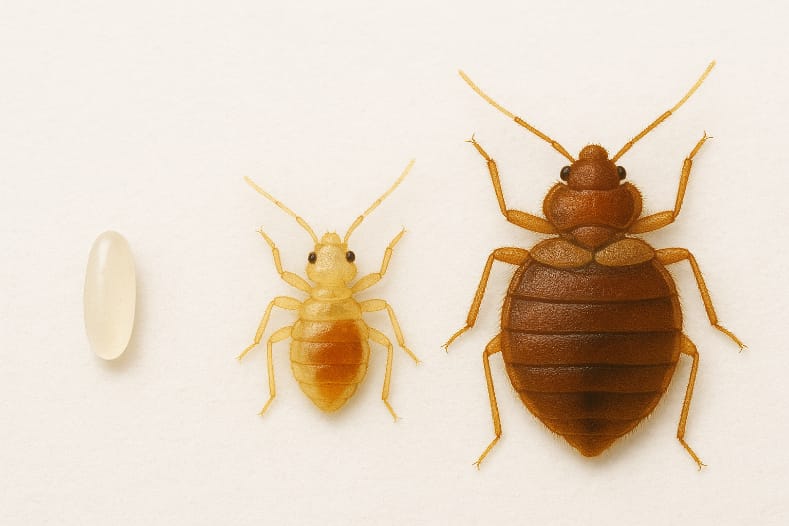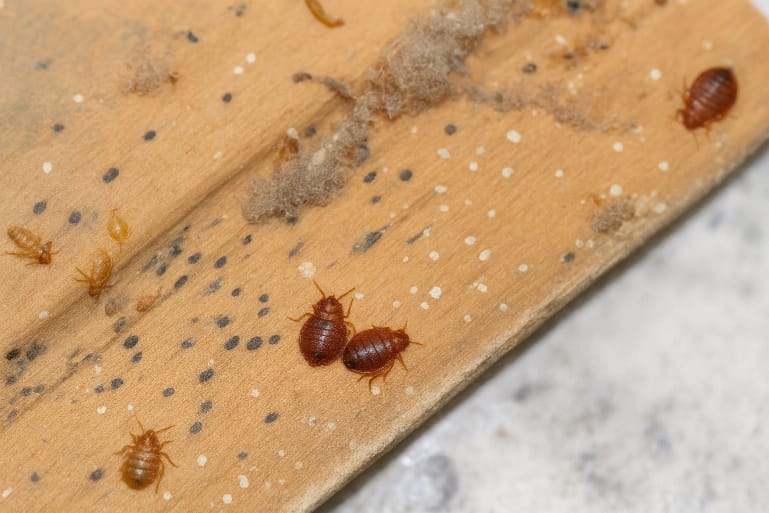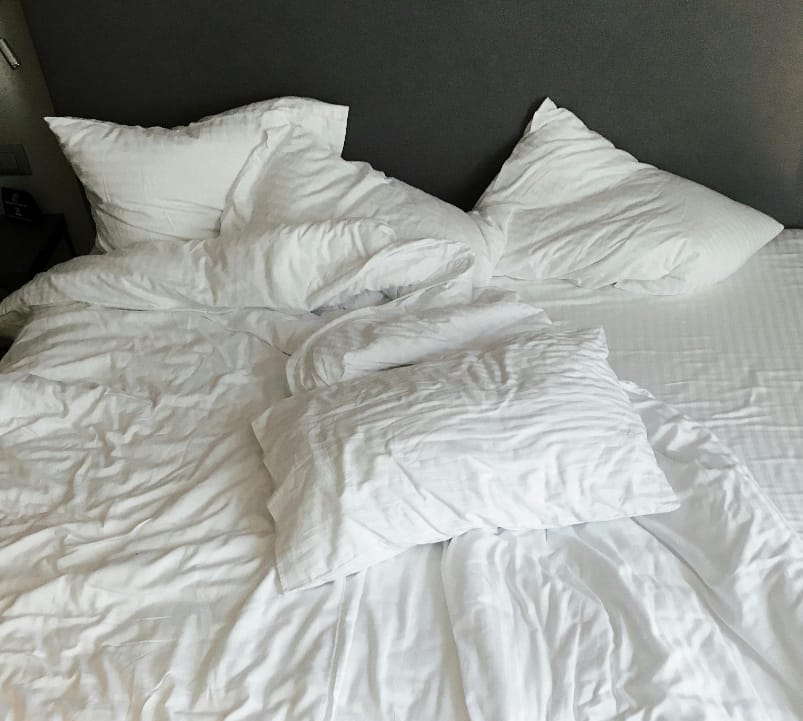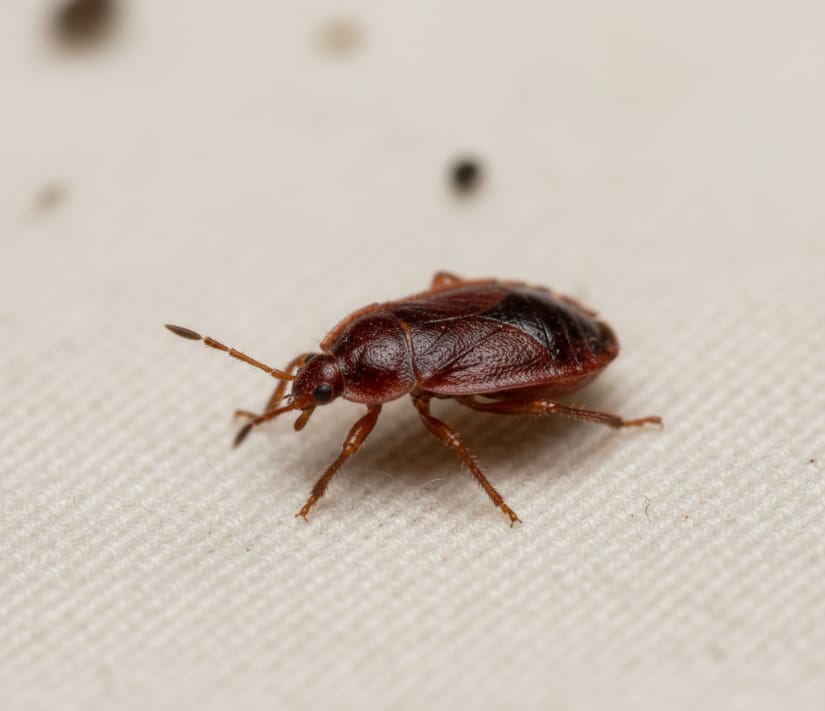What They Are, How They Spread, and What to Do About Them
Worried you might have bed bugs? You’re not alone.
Bed bugs are becoming more and more common across Southern Utah, including in places like Kanab, St. George, Cedar City, and the surrounding counties. And while the idea of bed bugs might make your skin crawl, understanding what you’re dealing with is half the battle.
In this guide, we’ll break down everything you need to know about these persistent pests, from what they look like through each life stage to how they spread, bite, and hide. We’ll also answer the top questions homeowners ask us and let you know exactly what to do if you think you might have bed bugs.
What Are Bed Bugs?
Let’s start with the basics.
The scientific name for the common bed bug is Cimex lectularius. Picture this: a tiny, flat, oval-shaped bug about the size of an apple seed. Adults are reddish-brown and become more of a rust color after feeding. If you catch one before it’s had a meal, it’ll look flatter and lighter in color.
Baby bed bugs called nymphs are much smaller and lighter in color, almost translucent. They darken after feeding but can be hard to see against light-colored fabrics. And then there are the eggs: white, pinhead-sized, and sticky, usually tucked deep into mattress seams or tiny cracks.
Unlike fleas or ticks, bed bugs don’t live on their host. They come out to feed usually at night then slip back into hiding. They’ve been hitchhiking with humans for thousands of years and can squeeze into cracks thinner than a credit card. That makes them incredibly good at staying hidden, and incredibly tough to get rid of without professional help.
Life Stages: What Bed Bugs Look Like
Understanding how bed bugs change throughout their life can help you spot an infestation early.

1. Egg (1mm)
- Tiny, white, and oval-shaped
- About the size of a grain of salt
- Often laid in tight cracks or seams, glued in place
2. Nymph (1mm–4.5mm)
- Clear to light tan in color
- Looks like a mini bed bug
- Turns red after feeding
- Sheds skin 5 times before reaching adulthood
3. Adult (4.5mm–7mm)
- Flat, oval body
- Reddish-brown color
- About the size of an apple seed
- Can live several months without feeding
Here in Southern Utah, we often get calls when someone finds small rust-colored stains or black dots on sheets or mattresses classic signs of feeding and waste from nymphs or adults.
Where Do Bed Bugs Live?
Contrary to what the name suggests, bed bugs aren’t just found in beds. They’ll make a home anywhere they can hide near a food source (that’s you). Common hiding spots include:
- Mattress seams and box springs
- Headboards and bed frames
- Baseboards and wall cracks
- Upholstered furniture
- Behind picture frames or wall outlets
- Inside luggage or clothing
Now, here’s where it gets tricky. Bed bugs are natural hitchhikers. They don’t need wings or speed just opportunity. When you stay at a hotel, visit a friend’s house, or rent a vacation home, bed bugs can sense your body heat and carbon dioxide as you sleep. Once they feed, they look for the nearest tight, dark space to hide and that often ends up being your suitcase, backpack, or clothing pile on the floor.
Because they’re so small and flat, they can slip into the lining of luggage or hide inside zippers and seams without being noticed. Then, without realizing it, you bring them home. By the time you’ve unpacked, they’ve already found a new hiding spot in your home, ready to feed again.
That’s why we always recommend inspecting hotel rooms carefully and keeping your luggage off the floor and bed. It’s also a good idea to wash and dry your clothes on high heat after returning home from any trip.

How Do Bed Bugs Spread?
Bed bugs don’t fly or jump but they’re expert travelers.
They move by crawling, often hopping into suitcases, clothing, or used furniture. That’s why infestations can happen even in clean homes. In fact, some of the worst infestations we’ve treated in Cedar City and Washington County started from a single used couch or hotel stay.
They also spread within multi-unit buildings, moving through walls, floors, and shared HVAC or electrical systems.
Bed Bug Bites: What They Look Like
If you’re waking up with mysterious itchy bumps, bed bugs might be to blame.
Bed bug bites often appear in clusters or lines typically on areas of skin exposed while sleeping (like arms, neck, shoulders, and legs). Bites are:
- Small, red, and itchy
- Sometimes slightly swollen
- Often show up in rows or groups of three (“breakfast, lunch, and dinner” pattern)
- May take days to appear after the bite occurs
Everyone reacts differently; some people don’t show any symptoms at all, while others develop rashes or allergic reactions.
Signs of a Bed Bug Infestation
Wondering what to look for around your home? These are the biggest red flags:
- Blood spots on sheets or pillowcases
- Dark fecal spots on mattresses, furniture, or walls
- Bed bug shells or skin sheds (tiny, dry casings)
- Musty, sweet odor (from bed bug scent glands)
- Live bugs, especially along seams or in tight spaces
If you’re noticing any of the above or just have a gut feeling something isn’t right it’s time to investigate further.
FAQ: Common Questions About Bed Bugs
What Kills Bed Bugs?
Bed bugs are tough but not invincible. Professional treatments are the most effective, often combining:
- Heat treatment (kills all stages, including eggs)
- Targeted insecticides
- Steam applications
- Vacuuming and encasements
Over-the-counter sprays rarely eliminate infestations and can sometimes make them worse by scattering the bugs.
Where Do Bed Bugs Hide on Your Body?
Good news: Bed bugs don’t live on people. They only come out to feed, usually at night, and then return to their hiding places.
You won’t find them burrowed into skin or hair like lice or ticks.
Are Bed Bugs Caused by Poor Hygiene?
Absolutely not.
Bed bugs are equal-opportunity invaders. They don’t care if your house is spotless or messy; they only care about access to a food source and places to hide. That said, clutter does make it easier for them to hide and harder to treat.
What Attracts Bed Bugs?
Bed bugs are drawn to:
- Body heat
- Carbon dioxide (your breath)
- Sleeping humans (quiet, still targets)
They aren’t drawn to food crumbs, dirt, or odors like some pests. They just want blood, and a quiet place to hide nearby.
What Are the First Signs of Bed Bugs?
Early signs to watch for:
- Small bites in lines or clusters
- Blood stains on sheets
- Dark dots or smears on mattress seams
- Shells or live bugs in furniture crevices
- Odd sweet/musty odor in bedrooms
Catch them early, and they’re much easier to eliminate.
Think You Might Have Bed Bugs?
If you’ve read this far and are nodding your head don’t panic.
Bed bugs are unsettling, but they’re beatable, especially if you act fast. At Newby’s Pest Control, we offer bed bug inspections starting at just $25. The best part? If we find bed bugs and you decide to hire us for treatment, we’ll knock that inspection fee off your final bill.
We’re fully licensed, local to Southern Utah, and known for fast, discreet service. Whether you’re in Wayne, Garfield, Iron, or Sevier County, we’ve got your back.
Click here to schedule your inspection now!

Final Thoughts
If there’s one thing to remember, it’s this: bed bugs aren’t your fault but they do need fast attention.
The longer you wait, the harder they are to treat. If you’ve got itchy bites, weird spots on your sheets, or a suspicion something’s not right, trust your instincts.
At Newby’s, we’ve been in this game a long time same team, same trusted service, just a new name. We know Southern Utah because we’re from Southern Utah, and we’re here to help you sleep easy again.
Need Help Right Away?
Call or text Cash at (435) 586-7337 to book an inspection, or visit our website to reach out to us to learn more.



